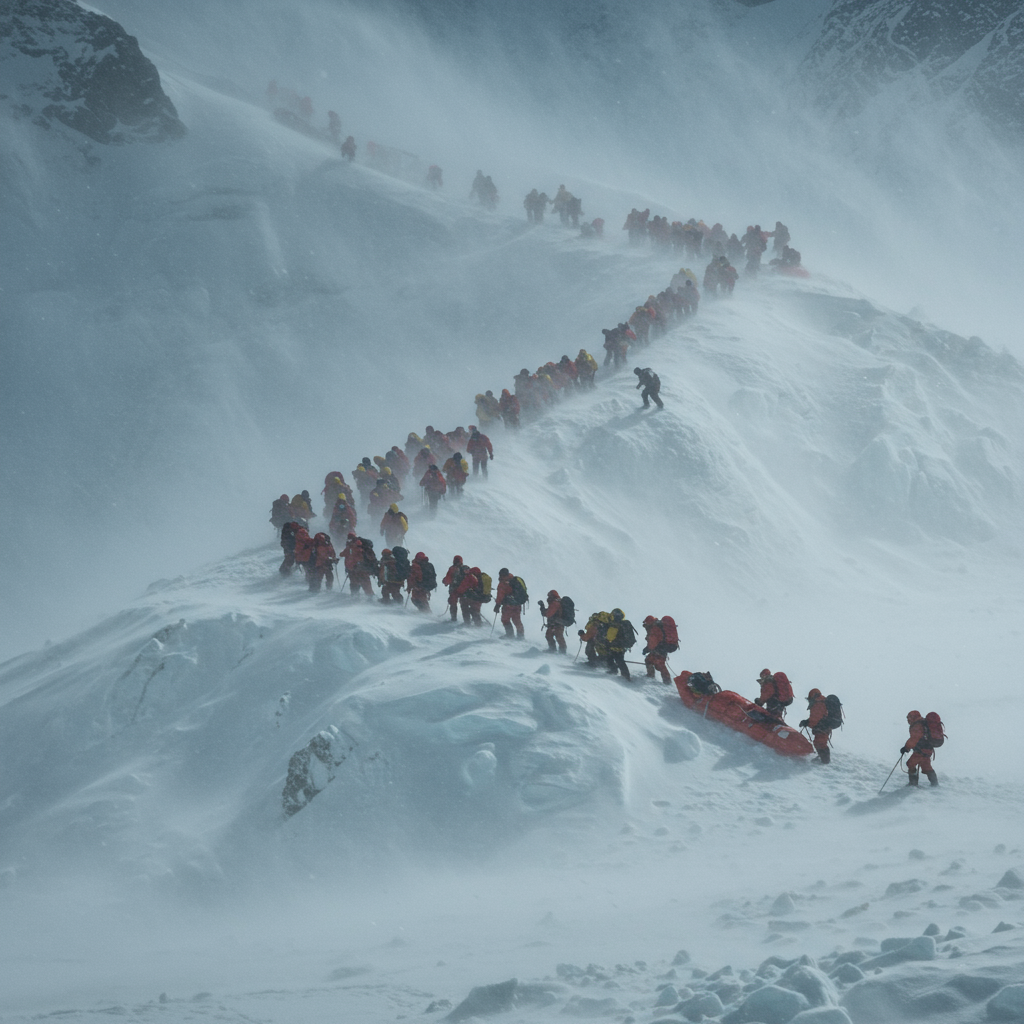An unprecedented blizzard recently transformed Mount Everest’s eastern slopes into a perilous trap, ensnaring hundreds of hikers and their support teams. This harrowing event unfolded during China’s usually festive Golden Week holiday, triggering a massive rescue operation that ultimately guided over 580 trekkers and 300 local staff to safety. The incident at an altitude exceeding 4,900 meters (16,000 feet) highlighted the unpredictable dangers of high-altitude environments, even in what is typically considered a favorable hiking season.
The swift and coordinated rescue effort saw police, firefighters, and hundreds of local Tibetan volunteers mobilize. They battled deep snow and treacherous conditions to reach the stranded groups. This dramatic saga serves as a stark reminder of nature’s formidable power and the critical importance of preparedness in the world’s most extreme landscapes.
Unprecedented Storm Traps Hundreds on Everest’s Eastern Slopes
The severe weather struck the eastern face of Mount Everest, specifically impacting hikers exploring the Karma Valley. This scenic but lesser-known route to Everest’s base is renowned for its breathtaking views. The heavy snowfall began unexpectedly on Friday evening, intensifying dramatically throughout the weekend. It caught everyone off guard, including seasoned mountain guides.
The Golden Week’s Treacherous Turn
October typically offers clear skies and mild temperatures in the Mount Everest region. This makes it a prime time for trekking. Thousands flock to the Himalayas during China’s eight-day Golden Week holiday, a peak season for local tourism. However, this year, the clear blue skies were replaced by a relentless whiteout. Snow accumulated rapidly, reaching depths of about a meter in some areas. This unprecedented event created a life-threatening situation for those on the mountainside.
The storm’s ferocity rendered usual hiking routes impassable. Paths vanished under thick snow. This forced trekkers into an arduous, slow retreat. Conditions became incredibly slippery with ice, leading to frequent falls. Authorities quickly suspended ticket sales and entry to the entire Everest Scenic Area as the blizzard raged.
Harrowing Accounts from the Mountainside
Survivors shared chilling accounts of their ordeal. Many described battling extreme cold and exhaustion. Hypothermia became a very real and immediate threat. Even adequately dressed individuals succumbed to its early symptoms.
Battling Hypothermia and the Deep Snow
Dong Shuchang, a 27-year-old nature photographer and experienced Himalayan visitor, recounted the terror. “I had never experienced weather like this,” he stated, detailing non-stop lightning and thunderstorms. Several people in his 20-person group showed signs of hypothermia. Windbreakers and raincoats offered little protection against the relentless, wet snow. Trekkers became drenched, further exacerbating the risk of a dangerous drop in body temperature.
Chen Geshuang, a member of Mr. Dong’s group, corroborated the severity. She described navigating through meter-deep snow during their retreat on Sunday. “This blizzard was still extremely difficult to deal with,” she recalled, despite their collective experience. Another hiker, Eric Wen, reported that three members of his group suffered from hypothermia. They had to constantly clear snow from their tents, often every ten minutes, to prevent them from collapsing under the immense weight. The fear of being buried alive by accumulating snow made sleep nearly impossible for many.
A Coordinated Rescue Amidst Treacherous Conditions
The rescue operation was a testament to human resilience and coordinated effort. Police, firefighters, and hundreds of local Tibetan volunteers sprang into action. They worked tirelessly through the night, navigating the same treacherous conditions that had trapped the hikers. Rescuers carried struggling trekkers on their backs through the deep snow.
The Crucial Role of Local Knowledge
Local communities played a pivotal role in the success of the rescue. Yaks were instrumental, not just for carrying supplies but also for carving paths through the deep snow. This animal wisdom potentially revealed dangerous chasms. Villagers in Qudang and surrounding areas provided essential aid. They offered warm food, hot tea, and much-needed shelter to the exhausted and hypothermic trekkers as they arrived. This local knowledge and immediate community support were critical in mitigating further casualties. While most were safely evacuated, a final group of about 10 hikers, accompanied by rescue workers, made it to a rendezvous point equipped with heating, oxygen, and emergency supplies before completing their journey to Qudang.
Unpacking the Unseasonal Weather Phenomenon
Experts were taken by surprise by the storm’s severity and its unusual timing. Rebecca Stephens, the first British woman to summit Everest, noted a discernible shift in Himalayan weather patterns. She explained that while the monsoon season typically concludes weeks earlier, heavy rainfall persisted in Nepal. This particular event delivered an exceptionally heavy snowfall on the Tibetan side.
Climate Change and Himalayan Weather Volatility
BBC Lead Weather Presenter Ben Rich provided further meteorological insight. He explained that while October often brings stable weather, it is also a period when potent low-pressure systems and cyclonic storms can form in the Bay of Bengal. This specific system drifted north, unleashing torrential rain and snow across the entire Himalayan range. This incident aligns with broader observations regarding climate change. Sherpa communities in Nepal are increasingly adapting to more unpredictable conditions. Climate change contributes to more frequent and dramatic climate shifts, posing growing risks to both climbers and the local communities who support them.
Broader Regional Impact and Lessons Learned
The Mount Everest blizzard was not an isolated event. The same powerful weather system wreaked havoc across the wider region. Neighboring Nepal experienced devastating torrential rains, leading to severe flooding and landslides. These catastrophic events claimed over 50 lives and swept away entire villages. Roads were washed out, further hampering rescue efforts. In China’s western Qinghai province, a separate mountainous incident saw one hiker die from hypothermia and altitude sickness, with 137 others evacuated.
This widespread extreme weather underscores the volatile nature of the Himalayas. It highlights the critical need for constant vigilance and robust preparedness. The incident also shed light on the challenges of obtaining timely and accurate information from the Tibetan Autonomous Region (TAR) due to stringent government controls during crises. Ultimately, the survival of so many trekkers is a testament to the swift, collaborative efforts of rescue teams and the invaluable local expertise.
Frequently Asked Questions
What caused the unexpected Everest blizzard during Golden Week?
The unprecedented Mount Everest blizzard during China’s Golden Week holiday was caused by a potent low-pressure system originating in the Bay of Bengal. While October usually offers clear skies in the region, this system drifted north, bringing unseasonal and intense snowfall to the Himalayas. Experts and seasoned trekkers noted this weather was highly unusual for the period, contrasting sharply with the typically favorable post-monsoon conditions.
What safety measures were crucial in the Mount Everest blizzard rescue?
Crucial safety measures in the Mount Everest blizzard rescue included the rapid deployment of emergency teams comprising police, firefighters, and hundreds of local Tibetan volunteers. The invaluable local knowledge was vital, with yaks used to clear paths and villagers providing essential aid like warm food and shelter in Qudang. Rendezvous points with heating, oxygen, and emergency supplies were also established for the most critical cases.
Is October still a safe month for hiking near Mount Everest?
While October has historically been a favored month for hiking near Mount Everest due to clear skies and mild temperatures, the recent blizzard highlights increasing weather unpredictability. Experts suggest that changing weather patterns, possibly linked to climate change, are making Himalayan conditions more volatile. While many successful treks still occur, this incident underscores the necessity for hikers to exercise extreme caution, prioritize up-to-date weather forecasts, and acknowledge that even typically safe seasons can present significant, unexpected dangers.




